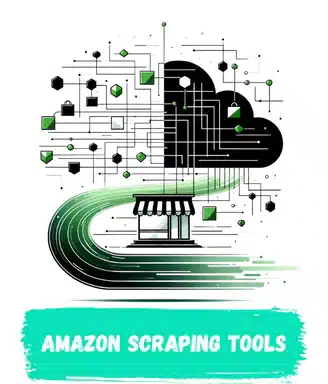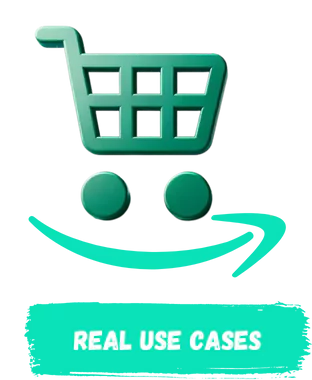Amazon’s vast online marketplace is a goldmine of data that holds the power to revolutionize your business decisions. From product listings brimming with customer reviews and pricing details, we are presented with an unprecedented wealth of information. But how to get your hands on this data? How to scrape Amazon? That’s what this guide will tell you. So get ready to know the ins and outs and take the 1st step to be an expert of Amazon web scraping!
We Covered Instagram Scraping, Facebook Scraping, WhatsApp Scraping, Google Search Scraping, LinkedIn Scraping, and Amazon proxy IDs in previous guides. Today: It’s the Amazon scraping turn.
Table of Contents
- What Do We Mean By Amazon Web Scraping?
- Amazon’s Anti-Scraping Defenses
- Dissecting an Amazon Product Page
- Tools and Techniques for Amazon Scraping
- How To Do Amazon Targeted Data Extraction Using Python?
- Amazon Scraping Real-World Use Cases
- Advanced Amazon Scraping and Practical Applications
- Amazon Data Handling, Storage, and Usage
- Basic Data Cleaning for Amazon Input
- Code Example: Cleaning a Scraped Amazon Review
- Main Takeaways
What Do We Mean By Amazon Web Scraping?
Web scraping is the technique used to extract data from websites – in this case, Amazon – and transform it into a format that allows for further analysis.
Given Amazon’s immense scale and unique structure, extracting this data poses certain challenges. The website’s complexity, frequent layout changes, and stringent anti-scraping measures all add to the difficulty of this task. However, these challenges are not insurmountable with the right approach and tools.
“Harnessing the power of Amazon’s data requires an understanding of web scraping, a knowledge of Amazon’s unique challenges, along with the skills to tackle them. The truth is, successful and ethical scraping is an art in itself.”
Amazon’s Anti-Scraping Defenses
Like many websites, Amazon has implemented measures to limit potential disruptors, including CAPTCHAs, IP-based rate limiting, JavaScript loading, and frequent site structure changes. Navigating these defenses will require a combination of strategic timetabling, rotating user agents, and potentially the use of amazon proxy servers.
1. CAPTCHAs
- What it is: Short challenges designed to distinguish between humans and automated bots (like web scrapers). These often involve distorted images of text or numbers, or selecting specific images within a grid.
- How to address: CAPTCHAs are difficult to bypass consistently. If frequent, you might need to consider manual intervention or using a CAPTCHA-solving proxy service.
2. IP-based Rate Limiting
- What it is: Limiting the number of requests a single IP address can make to Amazon’s servers in a certain time frame. Exceeding this rate limit can lead to temporary or permanent bans.
- How to address: Rotating IP addresses through proxies or residential IP networks can help distribute requests and avoid triggering this defense.
3. JavaScript Loading
- What it is: Amazon may use JavaScript to dynamically load some product or website content. This requires your scraper to be able to execute JavaScript, as simply looking at the plain HTML source code might not be enough.
- How to address: Use scraping libraries or browsers that can handle JavaScript rendering (such as Selenium or Playwright), or look for API endpoints if available.
4. Frequent Site Structure Changes
- What it is: Amazon may deliberately change the structure of their website to disrupt the functioning of web scrapers. This means that your code needs to be adaptable to HTML changes.
- How to address: Design robust scrapers that focus on identifying core elements that are likely to stay consistent despite site changes (e.g., product titles or price elements). Regularly test and update your code to maintain compatibility.
Dissecting an Amazon Product Page
The key to successful web scraping lies in understanding the structure of the site you’re targeting. When it comes to an Amazon product page, multiple crucial elements contain valuable information such as titles, descriptions, specifications, image sections, and pricing. By studying the HTML structure of these listings, you can identify the precise location of this data within the web page’s code, making extraction much simpler.
Note: Content within these elements can often change due to updates on Amazon’s backend, it’s essential to regularly validate your scraping scripts for accuracy.
Here’s a more elaborate breakdown of an Amazon product page’s structure:
Key Elements Of An Amazon Product Page
- Title: The primary name of the product. Usually found in large, bold text near the top of the page (within <h1> or similar header tags).
- Images: Multiple images including the main product photo and additional views. Often found within a carousel or gallery structure with image zoom functionality. (<img> tags with descriptive alt attributes).
- Price: Current selling price, along with potential discounts or reference to previous prices. Look for specific HTML classes or IDs related to pricing.
- Availability: Indicates if the item is in stock, out of stock, or has limited quantities.
- Variations: Many products have options like color, size, or configuration. These may be presented as dropdowns, buttons, or swatches.
- Buy Box: The crucial section containing “Add to Cart” and “Buy Now” buttons, as well as seller information if provided by a third party.
- Product Description: Detailed text describing features, uses, and specifications.
- Customer Reviews: Ratings and written reviews, including the average star rating. Can be extensive, sometimes containing images or videos.
- Frequently Bought Together / Sponsored Products: Suggestions for complementary items and advertisements based on the current product.

Tools and Techniques for Amazon Scraping
To effectively scrape data from Amazon, familiarity with core web scraping techniques and a few essential tools is necessary. Python, with its rich set of libraries, is a popular choice for building Amazon scrapers.
1. Python and Essential Libraries
- Requests: This library simplifies the process of sending HTTP requests to Amazon’s servers and retrieving the raw HTML content of product pages.
- Beautiful Soup: A powerful library designed for parsing HTML and XML. Beautiful Soup helps you navigate the structure of Amazon pages to isolate and extract specific data points.
- Selenium: When dealing with dynamically loaded content (where parts of the page are updated using JavaScript), Selenium is invaluable. It enables you to control a web browser, giving your scraper the ability to interact with elements, wait for content to load, and mimic a real user.
2. Amazon Proxy Servers
Amazon, like many large websites, has sophisticated anti-scraping defenses in place. One key defense mechanism is IP-based rate limiting. If Amazon detects too many requests coming from a single IP address within a short period, it may temporarily or permanently block that address.
Amazon Proxy servers help you bypass these restrictions by masking your true IP address, making your scraping traffic appear to originate from multiple locations. Read all about amazon proxy types and prices here.
3. Additional Tools
For more advanced projects, specialized scraping tools or frameworks like can offer greater structure, speed, and IP management features. These tools include:
- Scrapy: A powerful and flexible web scraping framework. Scrapy handles numerous complexities like managing requests, concurrency, and built-in proxy support, ideal for large-scale scraping projects.
- Headless Browsers: Like Selenium, tools such as Puppeteer and Playwright allow browser automation but with greater focus on speed and efficiency, useful for specific scraping scenarios.
- Cloud-Based Amazon Scraping Services: Services like Apify or Zyte (formerly Scrapinghub) provide managed infrastructure, and pre-built Amazon scrapers, saving development time. These may have associated subscription costs.

How To Do Amazon Targeted Data Extraction Using Python?
Let’s illustrate how to use these libraries for extracting common types of data from an Amazon product page like URL, Title, Reviews, Price and more.
Python Code:
import requests
from bs4 import BeautifulSoupproduct_url = “https://www.amazon.com/product-page”
response = requests.get(product_url, headers={‘User-Agent’: ‘Your User Agent’})
soup = BeautifulSoup(response.content, ‘html.parser’)# Product title
title = soup.find(id=”productTitle”).text.strip()# Price (handling dynamic updates)
price = soup.find(id=”priceblock_ourprice”).text.strip()# Reviews
reviews = soup.find_all(‘div’, {‘data-hook’: ‘review’})
for review in reviews:
rating = review.find(‘i’, {‘data-hook’: ‘review-star-rating’}).text
review_text = review.find(‘span’, {‘data-hook’: ‘review-body’}).text# … (Similarly extract image URLs, product specifications, etc.)
Important Notes
- Inspect Element: Always use your browser’s “Inspect Element” feature to understand the exact HTML structure of the Amazon page you’re targeting.
- User-Agents: Set a realistic User-Agent header to avoid bot detection.
- Responsible Scraping: Adhere to Amazon’s terms of service and robots.txt. Avoid excessive requests to prevent overloading their servers.
Amazon Scraping Real-World Use Cases
- Competitor price monitoring: Automated scraping of competitor listings on Amazon lets businesses track pricing shifts in real-time. This enables them to adjust their pricing strategies to stay competitive and maximize profit.
- Market Trend Analysis: Scraping product listings, sales ranks, and search volume data from Amazon offers a window into overall market trends. Businesses can use this to identify emerging niches, popular products, and gaps in the marketplace.
- Customer sentiment analysis on reviews: Large-scale review scraping from Amazon reveals what customers like and dislike about products. This sentiment analysis provides invaluable insights for improving product design, addressing common issues, and refining market positioning.
- Building your own product research tool: Scraping Amazon’s massive product catalog can power a custom product research tool. This tool might help you find profitable niches, identify potential product sourcing opportunities (for dropshipping or private-label), and get inspiration for product development based on common customer pain points.

Advanced Amazon Scraping and Practical Applications
Once you master the fundamentals of Amazon scraping, the following advanced techniques and real-world use cases become more accessible:
1. Handling Product Variations
- Identifying Variations: Inspect the source code of an Amazon product page. Look for elements (dropdowns, buttons, image carousels) that indicate selectable variations.
- ASIN Mapping: Often, each distinct variation has its own unique ASIN (Amazon Standard Identification Number). Your scraper will need to extract or derive these ASINs to fetch data for each variant.
- Iterating Requests: You might loop through variations, modifying a parameter in the product URL or submitting POST requests with variation data to retrieve details individually.
2. Large-Scale Review Scraping
- Pagination: Reviews often span multiple pages. Identify the pagination structure (e.g., “Next” button and its URL pattern) so your scraper can navigate through all available reviews.
- Rate Limiting: Amazon may become stricter with rate limits for review scraping. Distribute your requests over time using delays or a wide pool of proxies.
- Optimized Parsing: Focus on efficiently extracting the needed data (rating, text, reviewer) to minimize processing time for large numbers of reviews.
3. Price Monitoring and Tracking
- Schedule Scraping: Set up cron jobs or use a scraping framework to run your price-checking scripts regularly at desired intervals (daily, hourly, etc.).
- Dynamic Price Elements: Amazon might employ HTML obfuscation to make price scraping harder. Use broader CSS selectors or regular expressions to reliably locate price values.
- Storing Historical Data: Use a database or time-series tracking solution to store scraped prices, enabling you to visualize trends and get alerts about changes.
4. Error Handling and Data Validation
- Exception Handling: Use try-except blocks in Python to gracefully handle unexpected errors (e.g., unavailable product pages, sudden structural changes).
- Data Validation: Before storing scraped data, apply sanity checks: Does the price follow a realistic format? Are review ratings within the expected range?
- Logging: Implement logging to record successful scrapes, errors, and warnings. This will be crucial for debugging ongoing projects.
Amazon Data Handling, Storage, and Usage
The way you store and handle your scraped Amazon data will influence how easily you can analyze it and gain valuable insights. Here’s a look at suitable formats and essential cleaning considerations:
Choosing the Right Data Formats
1. CSV (Comma-Separated Values):
- Simple, flat-file format good for tabular data like product listings (title, price, features).
- Easily imported by spreadsheet software or analysis tools.
Limitation: Doesn’t handle nested data (like multiple reviews for a single product) well.
2. JSON (JavaScript Object Notation):
- Hierarchical format that can represent more complex data relationships.
- Well-suited for product data with variations, detailed reviews, etc.
- Widely supported for manipulation by programming languages.
3. Databases:
- Relational Databases (MySQL, PostgreSQL): Ideal for large-scale data with complex relationships and where you need to perform frequent querying.
- NoSQL Databases (MongoDB, DynamoDB): Flexible and scalable; a good fit for very large datasets or variable data structures.
Basic Data Cleaning for Amazon Input
Before storing or analyzing your scraped data, some cleaning steps are often necessary:
- Removing HTML Tags: Reviews and descriptions might contain HTML markup. Use libraries like Beautiful Soup or regular expressions to strip out tags and retain only the relevant text.
- Currency Formatting: Ensure price values are stored as numerical data by removing currency symbols and handling potential regional formatting variations (comma vs. period as decimal separator).
- Normalization: Convert text to lowercase for easier comparison and analysis then standardize date and time formats for consistency.
- Handling Missing Values: Decide how to handle empty fields (replace with “N/A”, exclude the entry, etc.).
Code Example: Cleaning a Scraped Amazon Review
from bs4 import BeautifulSoup
raw_review = “””<span data-hook=”review-body” class=”a-size-base review-text review-text-content”>
This product is great! I love it. <strong>Highly recommended.</strong>
</span>”””soup = BeautifulSoup(raw_review, ‘html.parser’)
clean_review = soup.get_text().strip() # Get plain text, remove extra whitespace
print(clean_review)
# Output: This product is great! I love it. Highly recommended.
Main Takeaways
- Amazon web scraping involves extracting data from Amazon’s website, a process that can be challenging due to the site’s complexity, frequent layout changes, and anti-scraping measures like CAPTCHAs and IP-based rate limiting.
- To navigate Amazon’s anti-scraping defenses, strategies such as using rotating user agents, employing proxy servers, and utilizing web scraping libraries that can handle JavaScript rendering are essential.
- Understanding the structure of an Amazon product page is crucial for effective data extraction, focusing on key elements like titles, pricing, availability, and customer reviews for accurate scraping.
- Python, along with libraries such as Requests, Beautiful Soup, and Selenium, is a popular toolset for building Amazon scrapers, allowing for the extraction of various data points including product titles, prices, and reviews.
- Beyond the technical aspects of scraping, it’s important to adhere to ethical practices by respecting Amazon’s terms of service, using realistic user agents, and implementing measures to prevent overloading Amazon’s servers, ensuring data is used responsibly for applications like competitor price monitoring, market trend analysis, and customer sentiment analysis.
Related:
- Tags:
- Amazon, how to scrape, python, web scraping



